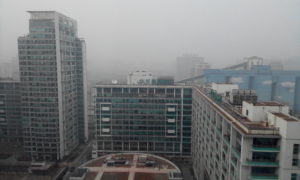New study hopes to reduce smog in Northern China while avoiding last year’s heating crisis
As the cold winter months approach, Northern China prepares to face a new smog season.
Smog (雾霾 Wù mái – literally fog haze in Chinese) is created primarily through coal burning from a chemical reaction between particulates in smoke and sulfur dioxide. The winter is by far the worst when it comes to China’s air pollution problem, as a majority of people use coal to fuel power, or burn it directly to heat their homes. According to Greenpeace, in 2016 coal provided 83% of the country’s heat.

Besides reducing visibility and detracting from aesthetic views, smog can also be dangerous to human health. Researchers estimate that China’s air pollution prematurely kills 1.1 million people a year.
In 2013, China declared a “war on pollution” to improve air quality and public health. Initial cuts in emissions in 2014 and 2015 caused a more than 25% decrease in pollution. In the four years since changes were first made, China has achieved a 32% reduction in air pollution. In comparison, it took 12 years and the 1981-1982 recession for the US to achieve the same reduction after the passage of the Clean Air Act. Progress in China has been astounding, however, change may be harder than indicated to bring about, as many cities in China avoid exceeding their annual pollution limit by simply shutting down factories near the end of the year. There have also been concerns in the past few years with an uptick in particulate pollution in late 2016 and early 2017 due to steel production increases from government stimulated demand.
Last winter, the Chinese government succeeded in reducing smog by 54% in the final quarter of 2017 compared to that of 2016 with a huge initiative to shift about 3 million households from coal to natural gas. However, this success came at a cost. The government’s attempts to cut back on coal burning near the capital caused gas shortages that reportedly left millions of people without heat or cooking fuel in sub-freezing temperatures.
Greenpeace’s Unearthed report analyzed Chinese social media posts on Weibo (the Chinese equivalent of Facebook) and found that efforts to curb pollution in the capital affected people’s heating systems up to 1,000 km away from Beijing.
As this winter fast approaches, the Chinese government seeks to reduce coal burning and smog while avoiding last year’s heating crisis. The government has ordered more than 4.5 million people to switch from coal to natural gas by the end of October, but this winter’s emission reduction targets have been revised from 15% to between 3% and 5%, signalling a more gradual shift away from coal.
According to a new study published jointly by Harvard University, Harbin Institute of Technology and Tsinghua University, another factor which may be contributing to the smog problem are formaldehyde emissions. The authors believe that reducing emissions of formaldehyde from vehicles and chemical and oil refineries may have a larger impact in reducing smog than the traditional efforts to reduce sulfur dioxide alone.
“Our research points toward ways that can more quickly clean up air pollution,” Jonathan M. Moch, Harvard researcher and lead author of the study, told the New York Times.
The study authors hope that their findings will help create new policy targeting formaldehyde that may help Northern China stay clear of smog. Both new policy and better preparation would ease efforts to prevent another heating crisis this winter.
Sources and Further Readings
Average monthly air quality index of Beijing, China from July 2016 to June 2017 – Statista
As smog season begins, China wary of leaving residents without winter heat – CNN
China’s Surprising Solutions to Clear Killer Air – National Geographic
Four Years After Declaring War on Pollution, China Is Winning – New York Times
Return of the smog: heavy industry threatens Beijing’s pollution fight – Greenpeace
China does U-turn on coal ban to avert heating crisis – BBC
‘I’m freezing and shaking’: China’s winter heating crisis, mapped – Greenpeace
China’s most polluted cities switch households to gas heating – South China Morning Post
A New Culprit Is Identified in China’s Choking Smog – New York Times
